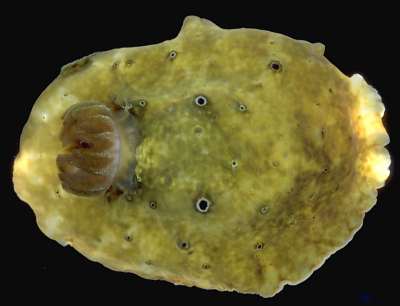
Actinocyclus verrucosus
Ehrenberg, 1831
Order: NUDIBRANCHIA
Suborder: DORIDINA
Superfamily: EUDORIDOIDEA
Family: Actinocyclidae
DISTRIBUTION
Tropical Indo-West Pacific.
PHOTO
Light colour form, Split Solitary Island, Coffs Harbour, nthn New South Wales, February, 1987. C152686. Photo: Bill Rudman
Until recently most specimens of Actinocyclus were identified as the single species Actinocyclus japonicus (Eliot, 1913) because of the difficulty in understanding earlier descriptions. Valdes (2002) reviewed the genus and has proposed we recognise two species, A. verrucosus and A. papillatus. The main synonyms of A. verrucosus are Sphaerodoris punctata Bergh, 1878, Sphaerodoris laevis Bergh, 1890, Sphaerodoris japonica Eliot, 1913 and Aldisa nhatrangensis Risbecia, 1956.
In general, the species of Actinocyclus have a tough leathery mantle, with a circlet of many short gills held in a cup-shaped arrangement similar to Hallaxa. In A. verrucosus the body is covered with low rounded tubercles, a few of which are relatively large. It ranges in colour from a yellowish brown to a dark grey brown, almost black. In lighter specimens small dark specks can be seen scattered evenly over the dorsum. The large tubercles usually have a black or very dark grey patch at the tip, often surrounded by a much lighter ring. It grows to at least 50mm in length.
- Bergh, L. S. R. (1878) Malacologische Untersuchungen. In: C.G. Semper, Reisen im Archipel der Philippinen, Wissenschaftliche Resultate. Band 2, Heft 13: 547-601,Pls.62-65.
- Ehrenberg, C. G. (1828 or 1831) Symbolae physicae seu
icones et descriptiones animalium evertebratorum sepositis insectis quae ex itinere per Africam borealem et Asiam Occidentalem--novae aut illustratae redierunt. Decas 1 Mollusca. - Eliot, C. N. E. (1913) Japanese nudibranchs. Journal of the College of Science, Tokyo Imp. University, 35: 1-47. (Pls.1-2)
- Risbec, J. (1956) Nudibranches du Viet-Nam. Archives du Museum National d'Histoire Naturelle Paris, 7 4, 1-34. (Pls. 1-22)
- Valdés, A. (2002) Review of the genus Actinocyclus Ehrenberg, 1831 (Opisthobranchia: Doridoidea). The Veliger 45: 193-202.
Rudman, W.B., 2005 (August 4) Actinocyclus verrucosus Ehrenberg, 1831. [In] Sea Slug Forum. Australian Museum, Sydney. Available from http://www.seaslugforum.net/find/activerr
Related messages
Actinocyclus verrucosus on prey sponge
February 1, 2006
From: Scott Johnson
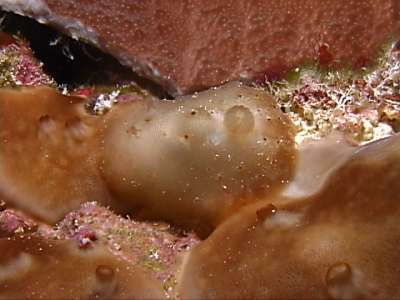
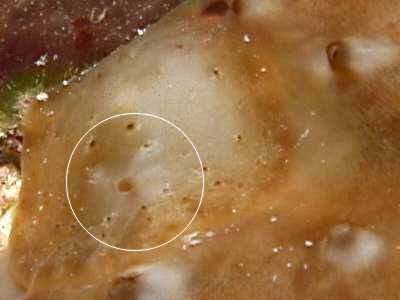
Hi Bill,
I ran across this Actinocyclus verrucosus well camouflaged on its prey sponge recently. The pattern on the body matches the sponge fairly closely and the gills, especially when retracted, resemble the sponge's oscula [second photo]. These were all captured from video, so they're a tad fuzzy.
Locality: Kwajalein Atoll, Marshall Islands. Pacific. Depth: 14 m. Length: 20 mm. 23 January 2006. Under rock in seaward reef channel. Photographer: Scott Johnson
Scott
uwkwaj@yahoo.com
Johnson, S., 2006 (Feb 1) Actinocyclus verrucosus on prey sponge. [Message in] Sea Slug Forum. Australian Museum, Sydney. Available from http://www.seaslugforum.net/find/15680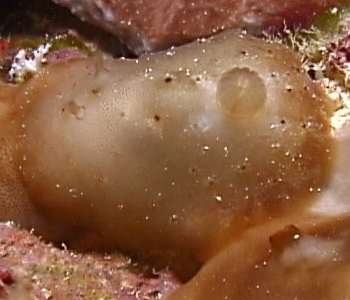
Thanks Scott,
I had always thought this was a remarkably well camouflaged species but I had never noticed the similarity between the sponge oscules and the gill pocket. I have ringed the retracted gill pocket in your photo.
Best wishes,
Bill Rudman
Actinocyclus verrucosus from Hawaii
September 23, 2005
From: Scott Johnson
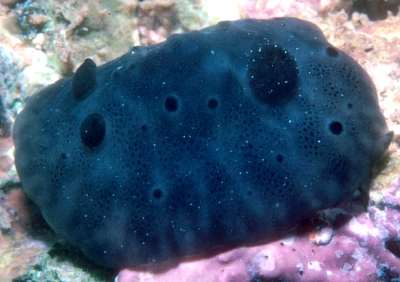
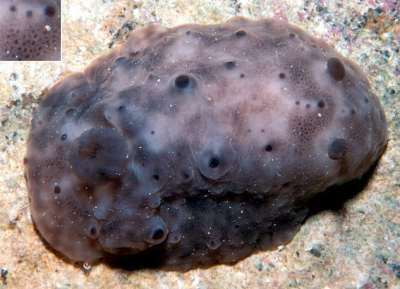
Hi Bill,
Here are a couple of Actinocyclus verrucosus from Hawaii. Both were found in shallow water under rocks. At least when I was hunting slugs in Hawaii, it was a pretty rare species.
Locality: Oahu, north and west shores, Hawaii, USA. Depth: 1-3 m. Length: 25 mm. 7 July 1979. Under rocks. Photographer: Scott Johnson
Scott
uwkwaj@yahoo.com
Johnson, S., 2005 (Sep 23) Actinocyclus verrucosus from Hawaii. [Message in] Sea Slug Forum. Australian Museum, Sydney. Available from http://www.seaslugforum.net/find/14814Thanks Scott,
Bill Rudman
Actinocyclus verrucosus (?) from the Marshall Islands
September 23, 2005
From: Scott Johnson
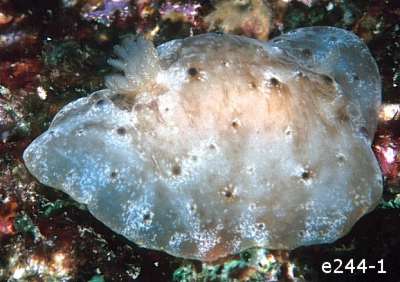
Hi Bill,
Here are some shots of what I think are all Actinocyclus verrucosus from the Marshall Islands. They all look a bit different, but all had the characteristics of Actinocyclus. The specimen from Enewetak (e244-4) seemed more papillose, but I still don't think it quite falls into the A. papillatus range. Details are:
e244-2 - Enewetak Atoll lagoon pinnacle, Marshall Islands. Pacific Ocean. Depth 10m. Length 32mm. Observed 29 January 1983. Under dead coral. Photographer Scott Johnson.
e244-1 - Kwajalein Atoll lagoon pinnacle, Marshall Islands, Pacific Ocean. Depth 8m. Length 40mm. Observed 1 July 1990. Under dead coral. Photographer Scott Johnson.
e244-3 - Kwajalein Atoll, leeward seaward reef, Marshall Islands, Pacific Ocean. Depth 7m. Length 40mm. Observed 6 December 1992. Under dead coral. Photographer Scott Johnson.
Scott
uwkwaj@yahoo.com
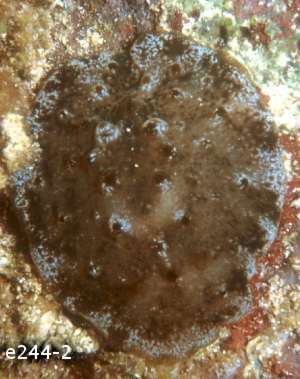
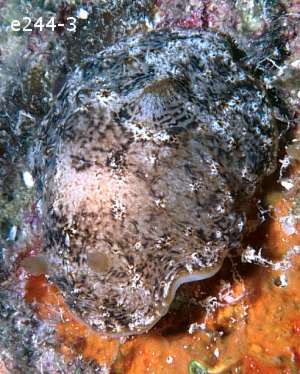
Thanks Scott,
I feel the same way about some I have seen - not quite papillate enough for A. papillatus.
Best wishes,
Bill Rudman
Re: Actinocyclus japonicus eggs
September 17, 2005
From: Gary Cobb
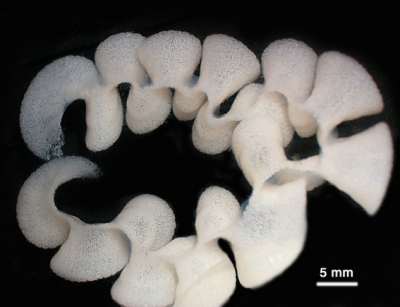
Hi Bill and everyone,
As you know we found Actinocyclus verrucosus earlier [message #14711], well while in my aquarium it laid an egg mass ... a lovely egg mass. Scale is on photo.
Locality: Old Woman Is, sthn Queensland, Australia. Depth: 14 m. Length: 45 mm. 08 September 2005. aquarium. Photographer: Gary Cobb
Cheers
Gary Cobb
gary@cobb.com.au
Cobb. G., 2005 (Sep 17) Re: Actinocyclus japonicus eggs. [Message in] Sea Slug Forum. Australian Museum, Sydney. Available from http://www.seaslugforum.net/find/14734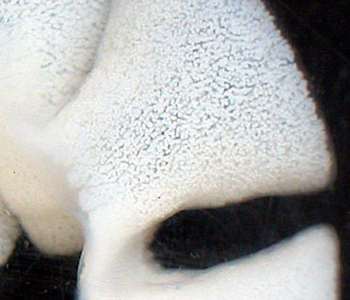
Thanks Gary,
It's great to get some egg mass information
Best wishes,
Bill Rudman
Actinocyclus verrucosus from southern Queensland
September 9, 2005
From: Gary Cobb
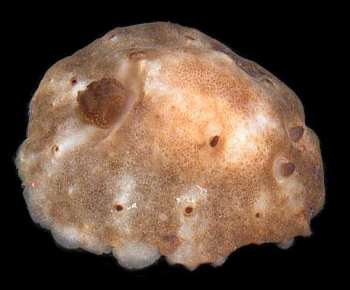
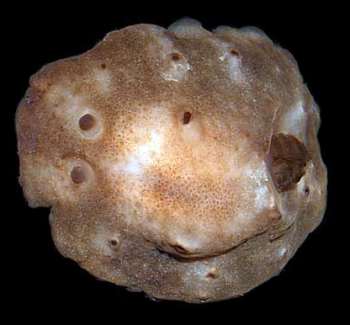
Hi Bill and everyone!
David and I were diving at the centre southern reef at Old Woman Is. off Mooloolaba and turned over lots of rocks. We found a very nice Actinocyclus verrucosus. Unfortunately I could not get it to reattach to the surface so I brought it home to photograph.
Locality: Mooloolaba, Queensland, Australia. Depth: 14 m. Length: 45 mm. 03 September 2005. subtidal. Photographer: Gary Cobb
Gary Cobb
gary@cobb.com.au
Cobb. G., 2005 (Sep 9) Actinocyclus verrucosus from southern Queensland. [Message in] Sea Slug Forum. Australian Museum, Sydney. Available from http://www.seaslugforum.net/find/14711Thanks Gary,
After reading your message I must say you have passed the test! Anyone who describes something as ugly as Actinocyclus as "very nice" has clearly proved to my satisfaction that they are a nudibranch fanatic.
Congratulations,
Bill Rudman
Actinocyclus verrucosus from eastern Australia [2]
August 10, 2005
From: Bill Rudman
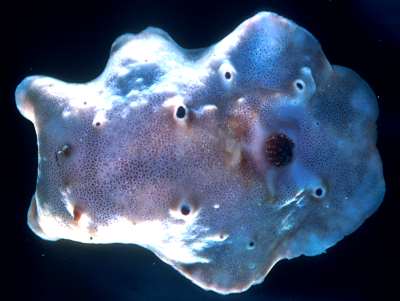
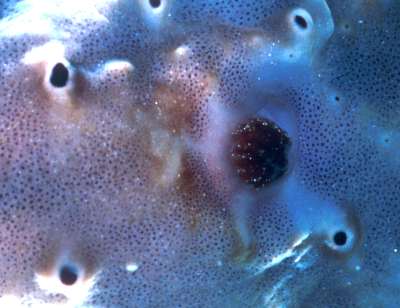
Here is a photo of what I presume is Actinocyclus verrucosus. Some of the papillae are quite large, but the are much less numerous, and the mantle is covered in small brown spots.
Locality: Solitary Ids, northern new South Wales, eastern Australia. 20 May 1982. 11 m. 36mm long alive 15 gills. AM C133691. Photo: G. Avern.
Bill Rudman
Rudman, W.B., 2005 (Aug 10) Actinocyclus verrucosus from eastern Australia [2]. [Message in] Sea Slug Forum. Australian Museum, Sydney. Available from http://www.seaslugforum.net/find/14527Actinocyclus verrucosus from eastern Australia [3]
August 10, 2005
From: Bill Rudman
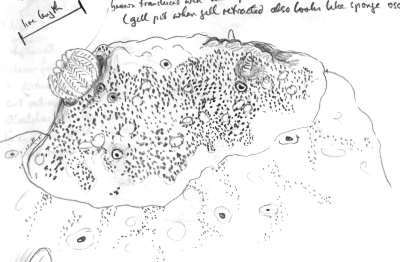
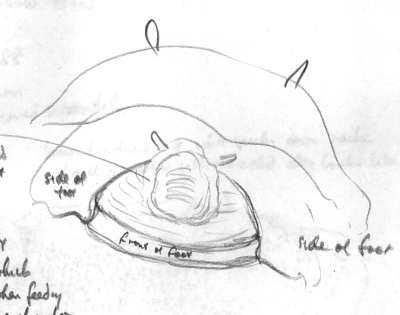
I have been trying to find a good photo of living Actinocyclus verrucosus without success but did find some field drawings I did of a specimen from northern New South Wales of an animal on its food sponge. Although not immediately obvious from photos taken of animals off their food, they are remarkbaly well camouflaged on their food sponges. In this case the sponge has similar brown specks to the animal, and the blackish spots on the tips of the papillae mimic the oscules or pores in the sponge colony. I have not had the sponge indentified, but it has the smooth leathery feel of a species of Halisarca
Locality: sth side Split Solitary Is., northern new South Wales, eastern Australia. 12 m. 18 Sept 1988. ['one eating sponge almost identical in colour. The black spots represent the oscules on the sponge colony' ]. 31mm long alive live length 3 cm. AM C157079. Drawings by Bill Rudman.
The lower drawing shows the head in action. One external anatomical feature of Actinocyclus is the way the head and anterior foot are fused so that when they are feeding, there is a small chamber formed over the sponge as the radula rasps bits of tissue off the colony. In the lower drawing the raised bit with the two little tentacles is the open mouth through which the buccalb bulb and radular ribbon are protruded, and you can see the side of the foot is joined to the mouth to form a hood. Dendrodoris has a similar arrangement, but I have always assumed that was independently developed for suctorial feeding, as a means of containing the digestive secretions exuded in those animals to partially digest the sponge more sucking it in.
Best wishes
Bill Rudman
Actinocyclus verrucosus from eastern Australia
August 4, 2005
From: Bill Rudman
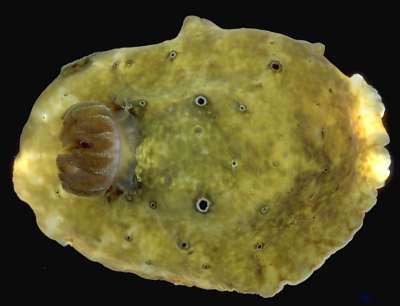
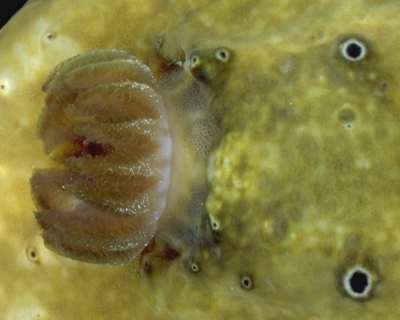
Here is a photo of an Actinocyclus which I had previously identified on the Forum as Actinocyclus japonicus (Eliot, 1913), simply because that was the oldest name that I could positively identify it with. Many other authors had followed the same course of action. Valdes's review (2002) suggests there are two species in the Indo-West Pacific, and that this sparsely nodulose form can be identfied with Actinocyclus verrucosus Ehrenberg, 1831 from the Red Sea
Locality: Split Solitary Island, Coffs Harbour, nthn New South Wales, February, 1987. C152686. Photos: Bill Rudman [more detail to be added]
Usually it is a darker colour than this and often has scattered dark specks.
Best wishes
Bill Rudman
billr@seaslugforum.net
Rudman, W.B., 2005 (Aug 4) Actinocyclus verrucosus from eastern Australia. [Message in] Sea Slug Forum. Australian Museum, Sydney. Available from http://www.seaslugforum.net/find/14471Actinocyclus verrucosus - egg ribbon
August 4, 2005
From: Bill Rudman
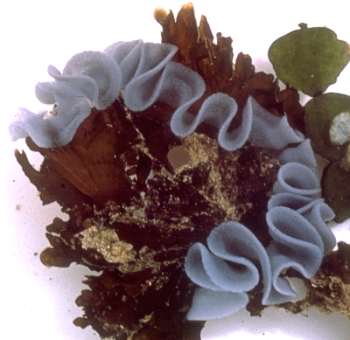
To accompany the other messages I am posting on Actinocyclus, here is a photo of the egg ribbon of Actinocyclus verrucosus from northern new South Wales, Australia. The animal was very similar to the one in my preceding message [#14471]
Locality: Broomes Head, northern New South Wales, Australia. 27 Mar. 1971, coll: J. Hunter & H. Woodward. Photo: Judith Hunter. AM C82041
Bill Rudman
billr@seaslugforum.net
Rudman, W.B., 2005 (Aug 4) Actinocyclus verrucosus - egg ribbon. [Message in] Sea Slug Forum. Australian Museum, Sydney. Available from http://www.seaslugforum.net/find/14472Actinocyclus japonicus eggs
October 17, 1998
From: Wayne Ellis
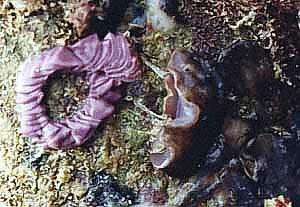
Note added 4 August 2004: This is Actinocyclus verrucosus.
Hi Bill,
Hope your feeling better. Attached is a pic of what I think is Actinocyclus japonicus laying eggs at Point Cartright Sthn Queensland.
Wayne Ellis
glaskin@ozemail.com.au
Ellis, W., 1998 (Oct 17) Actinocyclus japonicus eggs. [Message in] Sea Slug Forum. Australian Museum, Sydney. Available from http://www.seaslugforum.net/find/262Thanks Wayne,
I don't think I have seen its egg mass, but I have a vague memory it is this colour. Anyone else with information on its eggmass?
..Bill Rudman.
Actinocyclus in the Red Sea?
July 8, 1998
From: Erwin Koehler
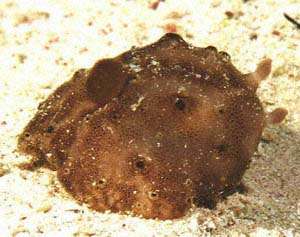
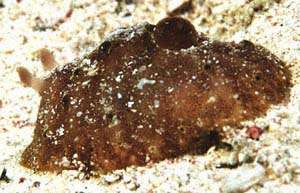
Dear Bill
I send 2 photos to you. I took them in the Red Sea at a nightdive in October 97. The size of the slug is about 1.5 cm (maybe smaller), depth 6-7m, place: Shabror, near Marsa Alam, Egypt. The rhinopores remind me of genus Dendrodoris. The thing at the back looked like a little bubble or ball, not like gills. Can you turn my "no idea" into ID?
Thank you
Erwin
Erwin Koehler
Darmstadt, GERMANY.
E.Koehler@deutschepost.de
Koehler, E., 1998 (Jul 8) Actinocyclus in the Red Sea?. [Message in] Sea Slug Forum. Australian Museum, Sydney. Available from http://www.seaslugforum.net/find/107Note added 4 August 2004: This is Actinocyclus verrucosus.
Erwin,
Your animal is almost certainly Actinocyclus japonicus, and if it is only 1.5cm long it is a juvenile because it can grow to about 12cm long. It is very hard and leathery to touch and the little "bubble-like" circlet of gills is very characteristic of Actinocyclus and the related genus Hallaxa. I often describe them as "goblet" shaped because of their resemblance to a wine glass. Some authors consider Actinocyclus and Hallaxa to belong in a distinct family Actinocyclidae. Apart from their goblet-shaped gill circlet their radular teeth bear a remarkable resemblance to those of some chromodorids. This is possibly a functional convergence as like, chromodorids, they tend to feed on sponges without spicules. I have found Actinocyclus and a number of species of Hallaxa on Dendroceratid sponges of the family Halisarcidae. These sponges form tough leathery, almost slimy layers over rocks or other hard surfaces and look more like a compound ascidian colony than a sponge, though they lack any obvious pores. Specimens of Actinocyclus japonicus range in colour and shape from a pale yellow with few spots and nodules to a very nodulose darker form. ... Bill Rudman
